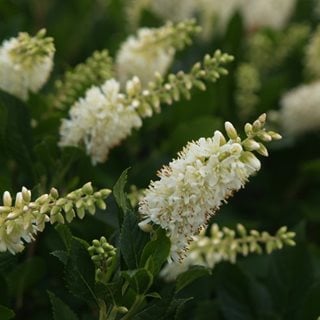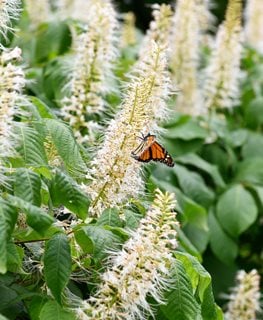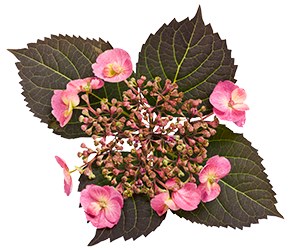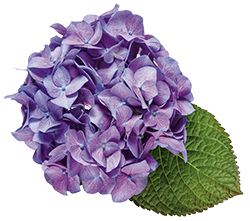Growing Summersweet for Late-Season Fragrance
Tips for planting, caring for, and using Clethra, a versatile summer-blooming shrub.Summersweet (Clethra alnifolia) is one garden plant that truly lives up to its name, producing an abundance of sweetly scented flowers during the waning days of summer, when few other shrubs are in bloom.
The showy bottlebrush-like flower clusters, some nearly a foot long, continue for weeks on end, attracting a steady parade of butterflies and bees with their seductive fragrance. Enhancing the prolific floral display are lustrous green leaves that turn brilliant golden-yellow in fall.
This sturdy native shrub is also remarkably adaptable, tolerating shade, soggy soil, and salty air, making it a valuable addition to woodland settings and coastal gardens.
On this page: Basics | Planting | Care | Summersweet Varieties | Landscaping Ideas
BASICS
Zones:
4-9
Plant type:
Deciduous shrub
Native area:
Eastern and southern North America
Exposure:
Full sun to part shade
Mature size:
Typically 3 to 8 feet tall and 4 to 6 feet wide, with the exception of dwarf varieties
Growth rate:
Slow
Bloom time:
Mid to late summer, with the blooms lasting 4 to 6 weeks
Flower colors:
White, pink, or rose
Foliage:
Glossy, dark green, and oval-shaped, with serrated margins
Special attributes:
- Attracts bees, butterflies, and hummingbirds
- Deer and rabbit resistant
- Salt tolerant
- Low maintenance
- Dark brown seed pods (similar in appearance to peppercorns) provide winter interest
HOW TO PLANT SUMMERSWEET
When to plant:
Plant in spring after the ground thaws or in early fall before it freezes.
Where to plant:
Native to swampy woodlands and marshes, clethra flourish in wet ground and will even tolerate standing water, making them a good choice for low-lying areas of the garden. They will thrive in coastal areas as well because of their resistance to salt spray and brackish water.
Ideally, plant these shrubs in a spot that receives morning sun and afternoon shade. They will also do well in full sun as long as you keep the soil moist.
Soil:
Prefers moist, acidic, sandy soil but will also tolerate clay soil if it’s amended with compost to improve drainage.
How to plant:
Dig a hole that is at least twice as wide as the root ball and just as deep. Place your shrub in the hole, gently spreading out the roots, and then backfill to ground level and water well. To get your plant off to a good start, work some organic matter into the soil and cover the root zone with a layer of mulch to help keep the soil cool and moist.
Spacing:
About 4 to 6 feet apart, depending on the size at maturity and the intended use. To form solid hedges, space plants a distance equal to their mature width.
SUMMERSWEET CARE
Watering:
Water regularly to keep the soil moist, especially during the first growing season. Once the roots became established, summersweet bush is somewhat drought tolerant, but avoid letting the soil dry out completely.
Fertilizing:
To jumpstart growth, feed in early spring with a slow-release fertilizer or an all-purpose organic plant food.
Pruning:
Prune as needed to maintain the desired shape and remove dead, diseased, and damaged branches. Because clethra bloom on new growth, prune during winter or early spring to avoid removing developing flower buds.
Controlling spread:
Summersweet spreads slowly by suckering roots and will colonize over time. If you don’t want your shrubs to naturalize, simply clip away the suckers from the base of the plant to maintain a more formal appearance.
Pests and diseases:
Has few insect or disease problems, with the exception of spider mites, which are more common when plants are stressed by hot, dry conditions.
SUMMERSWEET VARIETIES
LANDSCAPING IDEAS
Because of its versatility and modest size, summersweet bush has a multitude of uses in both formal and informal gardens. Here are ideas for taking advantage of its many attributes:
- Plant near a patio or other outdoor living space to fully enjoy the sweet-smelling flowers.
- Use in a mixed border with other spring- and summer-blooming shrubs that like moist soils, such as viburnum.
- Use as an underplanting beneath trees or in a woodland garden.
- Plant in a rain garden or along stream banks and ponds for erosion control.
- Grow taller varieties as hedges or privacy screens or as a backdrop in a perennial garden.
- Include in a butterfly garden or hummingbird haven to attract late-season pollinators.
- Plant dwarf summersweet cultivars in smaller garden beds to add structural interest and late-summer blooms.
RELATED:
Best Flowering Shrubs for Season-Long Color
20 Fragrant Flowering Plants
The Best Deer Resistant Plants for Your Garden
20+ Rain Garden Plants
21 Low-Maintenance Plants













